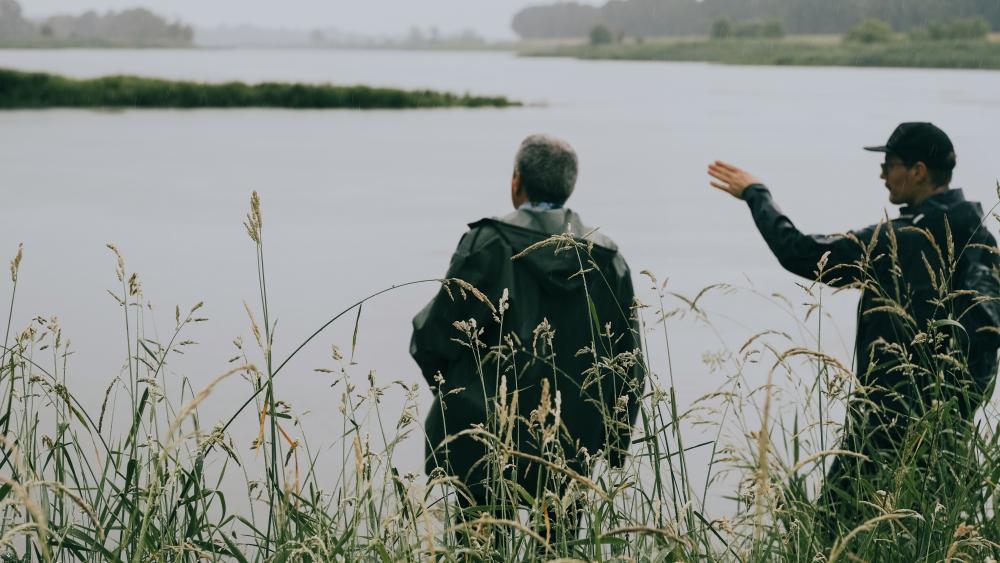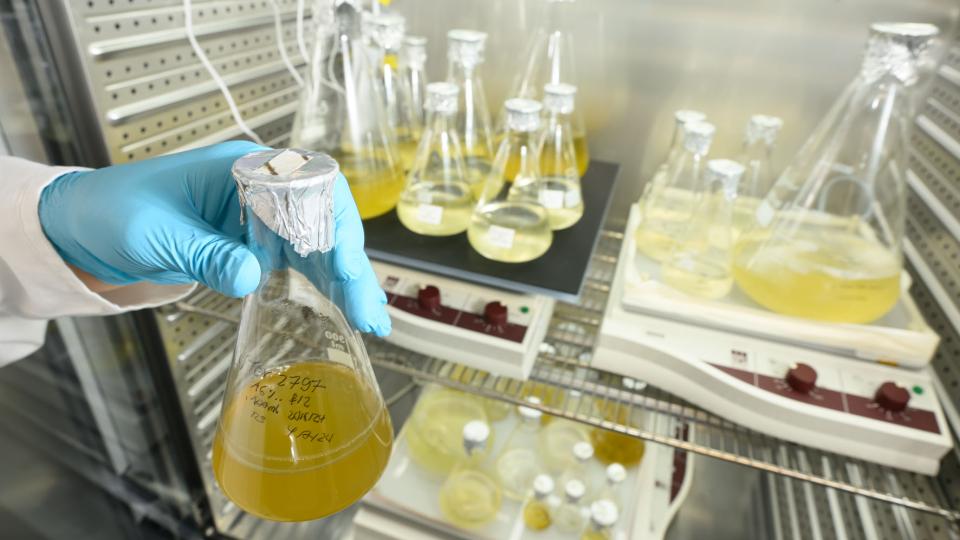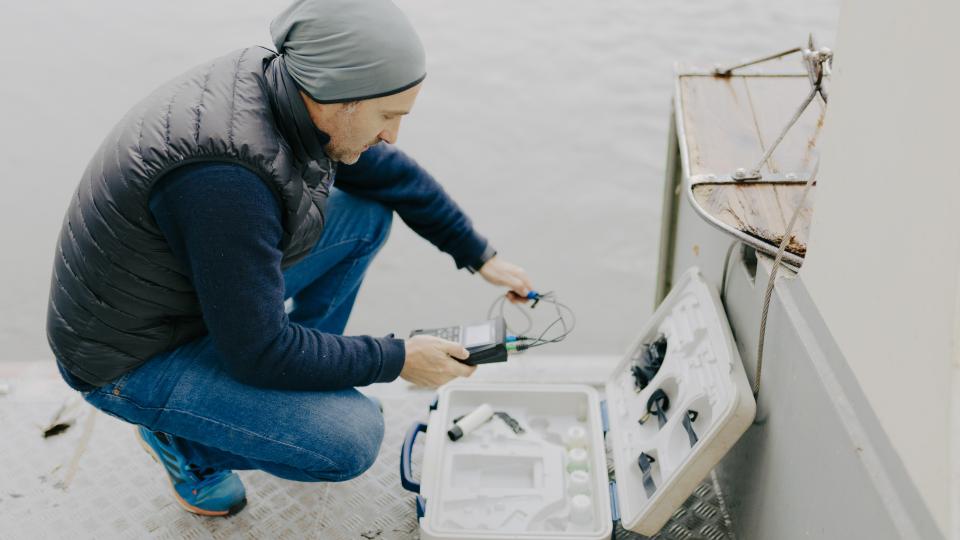
The Oder, a river that is still exposed to many pressures. | Photo: Lena Giovanazzi
When the first reports and pictures of dead fish in the Oder were published in the summer of 2022, no one initially thought of a salt- and still-water-loving toxic algae. However, the water parameters quickly led to the suspicion at IGB that algae could play a role. With the support of international partners, IGB was then able to identify the toxin-producing microalgae Prymnesium parvum as the cause of the fish and mussel mortalities.
The mass development of the microalgae with more than one hundred million cells per liter would not have been possible under natural conditions. It was due to a combination of chronic and acute factors – the constant high salinity and nutrient concentration, the reduction in flow velocity due to reservoirs or impoundments, and acute climatic influences such as many hours of sunshine, high air and water temperatures, and low water flow. This makes the Oder a prime example of compound ecoclimatic events, i.e. the interaction of (human-made) environmental changes and climatic factors.
Environmental disaster difficult to predict: A puzzle of causes instead of a single event
"In our perception of environmental disasters, we tend to think of a single trigger, such as an oil spill or chemical release. However, the Oder disaster of 2022 showed that it is often the interaction of several stressors that can trigger a disaster. The disaster is then often harder to predict because the complex interaction makes risk assessment more difficult. It is therefore always very risky to expose our ecosystems to these many simultaneous stresses, as happened and is still happening in the Oder", said Jan Köhler, lead author of the data synthesis.
The factors influencing the Oder disaster in detail
Salt pollution
In the upper catchment area of the Oder, mining in Upper Silesia led to intensive discharges of saline mine water over many years, although these are permitted by national legislation. This is usually common table salt. The conductivity (as a measure of salinity, measured in microsiemens per centimeter) of the Oder water (near Frankfurt/Oder) was between 401 and 2000 microsiemens per centimeter (µS/cm) between 2012 and 2022. It should be noted, however, that 2000 µS/cm is the maximum value that the sensor can measure. As background, the legal limit for conductivity is 850 µS/cm. ""However, the higher conductivity caused by the discharge of sodium chloride has received little attention in recent years, even when the salt content was well above the typical values of 300 to 800 µS/cm for large freshwater rivers, but did not appear to be dangerous for aquatic organisms", said IGB researcher Christian Wolter, co-author of the two recently published studies.
Some tributaries of the Oder exceeded conductivity values of 20,000 µS/cm in summer 2022. The main stream of the Oder was between 1000 and 2000 µS/cm in summer 2022; between August 6 and 14 it was well above 2000 µS/cm. This corresponds to a salinity of 1 gram per liter (g/L); brackish water is between 0.5 and 3 g/L. Samples taken on August 16, 2022 showed that table salt was the predominant salt at 0.7 g/L. Pre-industrial values or natural salinity levels cannot be determined due to a lack of historical data and also because of the diverse discharges. However, where the Oder is relatively unaffected for the first few kilometers along the Polish-Czech border, the baseline value is below 500 µS/cm.
Although P. parvum tolerates a wide range of salinities, the minimum growth limit is between 0.5 and 1 g/L, which corresponds to a conductivity of about 1000-2000 µS/cm.
"Mass development of the microalgae would therefore be impossible at the natural salinity of the river. And even if P. parvum could tolerate lower salinities, the algae would be at a competitive disadvantage compared to freshwater algae, and therefore this bloom could not occur", explained Jan Köhler. At present, the salt content in the Oder is still at 0.7-1 g/L because the causes have not been eliminated.
Nutrients: nitrate and phosphate
P. parvum is a predatory alga – aside from photosynthesis, it can obtain energy by using its toxin to kill other small organisms and absorb their cell contents. This means that it does not depend solely on nutrients from the water. However, high nitrate concentrations in water, for example from agricultural fertilizers, promote their growth.
In 2022, nitrate concentrations in the Oder were very high at up to 5 milligrams per liter (mg/L); just before the bloom in early August, the value was around 1.2 mg/L. Natural nitrate concentrations in rivers are around 0.1 mg/L. Phosphorus levels during the 2022 bloom were low, at 0.01 to 0.34 mg/L, and played a minor role in algal growth. "Nitrate inputs from the surrounding area are only slightly diluted when water flow is low and can accumulate in the reservoirs of the Oder. This can then strongly promote algae growth", said Jan Köhler. The nitrate concentrations are currently around 1-2 mg/L.
Low water
The water flow in volume per unit of time – known as discharge in hydrology – was persistently low in the summer of 2022. At the Eisenhüttenstadt gauge, the mean discharge in the months of June to August 2022 was around 85 cubic meters per second (m³/s), which was slightly above the lowest observed flow (63.6 m³/s on August 31 in 2015) and well below the long-term average low water (123 m³/s). This corresponds to less than a third of the average discharge for these days in the years 2000 to 2021.
The low flow rate led to a weaker dilution of the discharged wastewater, salts and nutrients. In addition, the flow velocity slowed down and the water depth decreased, which favored the mass development of algae. Due to the high precipitation in the first half of this year, the current flow rate is 110 m³/s, with a downward trend.
High temperatures
In the summer of 2022, a dry period that began in spring and above-average temperatures (reference period 1991-2020) in July led to a pronounced drought and heat wave in Central Europe. From June to August 2022, the average daily air temperature in Frankfurt/Oder was 21.9 degrees Celsius (°C) and the water temperature was 23.7 °C.
Although P. parvum prefers salt and brackish water, it also grows in lakes and reservoirs in a wide temperature range from 10 to 30 °C. In flowing water, however, optimal temperature conditions between 25 and 30 °C are required that the algae's growth rates can exceed the dilution effects of the water flow. In the summer of 2022, these temperatures were reached over a longer period of time in the Oder, especially in the reservoirs from mid-June. The water temperature had already exceeded 27°C this year, but is currently below 24°C due to precipitation and associated cooling.
River regulation and impoundments
Strong regulation of natural flow and impoundments are important factors influencing the development of algal blooms in rivers. Only "pre-breeding" in an impoundment could lead to the algal bloom in the Stromoder. The area of water with the required long retention time was probably Żelazny Most, which collects the salty mine water from the copper mines and is also discharged into the Oder. In fact, high concentrations of chlorophyll a were observed there and in the Gliwice Canal in July and August 2022. This green plant pigment, which is required for photosynthesis, is considered an indicator of algae growth in aquatic systems. At the same time, the low water conditions in the lower reaches of the Oder allowed continued growth of P. parvum, which continued in the main Oder, as shown by the indicators of daily metabolism (pH value, dissolved oxygen).
As part of the ODER~SO project, IGB is currently investigating how the various stress factors interact in the development of P. parvum blooms and toxin production using water samples from the Oder and cell cultures. In addition, IGB researchers have recently sequenced the complete genome of the algae strain in the Oder and identified the gene sequences responsible for toxin production.
How the animals in the Oder are currently faring: only half as many fish and 60 percent fewer mussels
Since 1998, IGB has fished the Oder at least three times a year for research purposes in the middle of the river and on the banks, so that Dr. Christian Wolter and his team have very precise knowledge of the dynamic development of fish stocks in the Oder. These long-term data are a prerequisite to compare the extent of fish mortality with the previous situation.
In the post-disaster fish and shellfish inventory, the researchers looked at both the density of the different species and their distribution in the different habitats of the river. "The two key factors of resilience – resistance and recovery – are determined in fish populations by refuge and dispersal, both of which we explicitly took into account in our observations", explained Christian Wolter.
Fish densities decreased significantly in all habitats studied, with the exception of the banks of the lower Oder. In comparison, the middle Oder was most affected, with a relative decline of about 55 percent for all species and in all habitats, although the decline was greater in the middle of the river than on the banks. Fish densities of species typical of the middle and lower reaches, such as bream (Abramis brama), ruffe (Gymnocephalus cernua), and barbel (Barbus barbus), declined by more than 70 percent. In addition to fish, mollusks – mussels and gilled snails – were also severely affected: Between 47 and 83 percent of mussels (Anodonta and Unio genera) and about 90 percent of snails were decimated in some places. On average, 63 percent of mussels died.
In terms of distribution, it became apparent that the fish reacted to the toxic algal bloom and, where possible, sought out other habitats: Barbel, ruffe and zander migrated from the middle of the river to the banks, while most species moved to downstream sections. This behavior can be deduced from the catch numbers and locations.
Implications for management on the Oder
Christian Wolter summarized the findings: "These escape routes are crucial for the survival and recovery of fish stocks. This shows the importance of riparian structures and floodplains as refuge areas for fish and the importance of good longitudinal connectivity. To strengthen the river's resilience, it is crucial to reduce nutrient loads and conductivity in the short term, especially during prolonged low flows. To achieve this, discharge permits will need to be changed from regulating loads to limiting maximum allowable concentrations in water bodies. The complexity of this catastrophic event highlights the urgent need to rethink the current mismanagement of rivers. Resilient rivers are the backbone of a climate resilient landscape. On the contrary, further developing them for shipping or maintaining them with all the rigours of water management is not sustainable and weakens the landscape water balance. We therefore advocate holistic approaches to water management to minimise the risk of eco-climatic disasters."
Unpredicted ecosystem response to compound human impacts in a European river

On algae cultures of Prymnesium parvum, IGB researchers are now also investigating the complex interaction of various environmental factors that can trigger algal blooms. | Photo: David Ausserhofer, IGB

Sturgeons are also being released back into the Oder as part of the reintroduction project. | Photo: Jacobia Dahm

The Oder is regularly fished and sampled after the disaster. | Photo: Lena Giovanazzi









